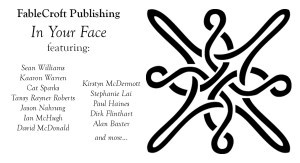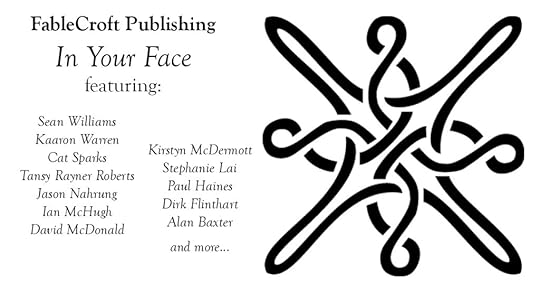Tehani Croft Wessely's Blog, page 5
February 18, 2016
Revisiting Pern, the great McCaffrey reread: RED STAR RISING (or) DRAGONSEYE
Tehani and Marisol bonded over Pern (and Doctor Who) at a science fiction convention, decided that it was time for a reread of the series, and really, they should blog about that. They are reading in Anne McCaffrey’s preferred way, which is basically publication order.
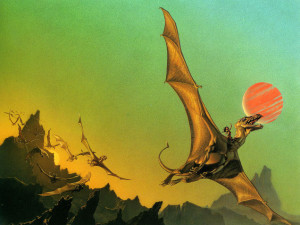 Pern Series –
The Chronicles of Pern: Red Star Rising
Pern Series –
The Chronicles of Pern: Red Star Rising
T: This was the first time in the reread I felt like I was reading a book for the first time. It’s NOT the first time I’ve read it, of course, but I had so little recollection of the events of the story it was like coming to it fresh. I think that was partly because all of the characters are new, so there was no context for the story outside of Pern itself?
M: I felt the same! The rest of the series really focuses around two different time periods, right around First Fall and ‘current’ era. I really enjoyed seeing the societal changes (and what’d remained the same).
It made me wonder if Anne had had more time if she’d have kept filling in the timeline, or kept with only forward stories.
T: I imagine that would probably have happened, yes. Although there would have been no objections from me if she’d had a brilliant idea for a story about the “next generation” after Jaxom, Lessa, F’lar, Menolly, Piemur etc, either!
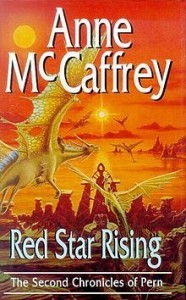 M: Another fun aspect in this book is how there’s more mentions of what happened pre-Pern. There wasn’t a lot in Dragonsdawn, like you’d expect. In particular, there’s a conversation between the what will someday be Harpers regarding professors and instructors only being respected on Earth after allowed use classroom discipline and stunners. It’s one of the only predictive future bits we ever hear about old Earth in her books, and I found it oddly fascinating given the escalating violence concerns in schools now. Perhaps she’ll have the right of it.
M: Another fun aspect in this book is how there’s more mentions of what happened pre-Pern. There wasn’t a lot in Dragonsdawn, like you’d expect. In particular, there’s a conversation between the what will someday be Harpers regarding professors and instructors only being respected on Earth after allowed use classroom discipline and stunners. It’s one of the only predictive future bits we ever hear about old Earth in her books, and I found it oddly fascinating given the escalating violence concerns in schools now. Perhaps she’ll have the right of it.
T: I really liked that way she seeded stuff like that, and in some ways for me, that’s what makes it really *feel* like science fiction. McCaffrey took what she saw in the world at the time and extrapolated on it to a distant (or perhaps not-so-distant) future.
M: Lord Chalkin is the big bad in this book, and there seems to be a theme with certain holds having horrible Lord Holders with no redeeming qualities (Lord Meron, anyone?). Wow, what a wretched human being. I mean, at first he doesn’t seem too bad, more crotchety and difficult than evil. As Leopol said to poor Iantine after being rescued from Bitra, “Did you know even wherries won’t roost in Bitra Hold?”
T: What’s that saying about great power and great responsibility? It seems to be a theme McCaffrey felt strongly about…
M: But seeing the descent from that level to containment camps where his people were starved, hung up, and raped – his depravity was stunning. And then to go further and find out about the cold storage… I still get chills thinking about it. The stuff nightmares are made of.
T: It’s kind of serial killer level, really, or an interesting commentary on refugees, to an extent, well before the current issues we have in that area.
M: I suspect there’s commentary there about refugees and how we handle atrocities, as she’d have plenty of experience through the previous century to draw out of. Up to and including the sadly predictable deniers.
T: Very true.
M: What did you think about the Weyr and the dynamic between K’vin and Zulaya? I got the impression that Zulaya was directing K’vin the whole time, whether he realized it or not, and there was a growth in their relationship as they seemed to come together and merge as a team by the end. I was glad to see her not portrayed as some sort of sneaky, underhanded person, either.
T: Oh heck yes! For starters, Zulaya is quite a bit older than K’vin, so it doesn’t surprise me at all that she was moulding him, somewhat, to help him become the best Weyrleader he can be. But also, he was clearly looking for her support, and she quietly gave it, probably even when he didn’t realise it.
M: Also: female riders! I really want to know what caused women to stop being allowed for green dragons. I’m guessing we are to infer from Debera’s story that people got worse about letting their kids be Searched?
T: I think so! I think McCaffrey took the opportunity in stories like this to explore the reasons why societies change in the directions they do, and I find that fascinating! Interesting particularly how a significant mass death event (ie: the plagues) really affect a society like Pern.
M: This book was a great gap filler for where and how Pern society has progressed since Landing. It’s a good read, even if it leaves me wanting more of these gap fillers. Pern is an incredible fascinating society, regardless of what point in time we see them.
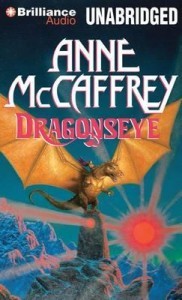 Previously, in the Great Pern Reread of 2015:
Previously, in the Great Pern Reread of 2015:
The Harper Hall trilogy (Dragonsong, Dragonsinger, Dragondrums)
Moreta: Dragonlady of Pern / Nerilka’s Story
The Chronicles of Pern: First Fall
The post Revisiting Pern, the great McCaffrey reread: RED STAR RISING (or) DRAGONSEYE appeared first on FableCroft.
Huge congratulations to all the Aurealis and Ditmar Awards finalists!
 We’re ecstatic to see several FableCroft mentions on the 2015 Aurealis Awards and 2016 Ditmar Awards (covering the same year of work…) shortlists.
We’re ecstatic to see several FableCroft mentions on the 2015 Aurealis Awards and 2016 Ditmar Awards (covering the same year of work…) shortlists.
In the Aurealis Awards, special mention to Dirk Flinthart, finalist for Best Collection for Striking Fire AND for Best Horror Novella with “Night Shift” from the collection, Joanne Anderton, shortlisted for Best Science Fiction Short Story with “2B”, and DK Mok, shortlisted for Best Fantasy Short Story with “Almost Days” (both stories being from Insert Title Here). It’s also super exciting to see Focus 2014: highlights of Australian short fiction on the Best Anthology list.
The complete shortlists are available on the Aurealis Awards website, and showcase some of the absolute best of Australian writing produced in 2015 – such an honour to be part of it!
For the Ditmars, it’s fantastic to see Joanne Anderton double up with “2B” on the Best Short Story ballot, alongside Deborah Biancotti’s creepy Cranky Ladies of History story “Look How Cold My Hands Are”. The Cranky Ladies anthology also made the Best Collected Work ballot, and Kathleen Jennings’ gorgeous cover and internals for the book are shortlisted for Best Artwork. Editor Tehani Wessely is also on the ballot for the William Atheling Jr Award for Criticism or Review for both the team efforts of “Squeeing Over Supergirl” (with David McDonald) and “Reviewing New Who” (with David McDonald and Tansy Rayner Roberts). If you were a member of Swancon last year, or of Contact 2016 this year, you are eligible to vote, so please do (for ANY of the fabulous work shortlisted!).
Congratulations to everyone appearing on these shortlists – it really shows the strength of Australian speculative fiction.
The post Huge congratulations to all the Aurealis and Ditmar Awards finalists! appeared first on FableCroft.
February 10, 2016
Revisiting Pern, the great McCaffrey reread: THE DOLPHINS OF PERN
Tehani and Marisol bonded over Pern (and Doctor Who) at a science fiction convention, decided that it was time for a reread of the series, and really, they should blog about that. They are reading in Anne McCaffrey’s preferred way, which is basically publication order.
 Pern Series –
The Dolphins of Pern
Pern Series –
The Dolphins of Pern
M: This was one of my favorite Pern books growing up, and after reading it, I’d still say it’s in the top 5. I really enjoy seeing the fallout AIVAS caused on all of Pern, and this is a special subset affected – those who love dolphins and want to reestablish a working relationship with them.
(I was raised on a steady diet of Flipper and The Little Mermaid, so it’s no surprise I enjoyed a story about dolphins. Which, like other sea mammals, seem horribly underrepresented in sci-fi/fantasy until recently. I guess I’m not the only one who finds them fascinating.)
T: Flipper? You watched FLIPPER? Woah. (I didn’t really get to watch that show, as our television access was spotty, to say the least, when I was a kid!). I’ve always loved dolphins too, so yes, having a book ostensibly about a society revolving around dragons being about dolphins was pretty much going to hit about a million of my “yes please” buttons!
M: Hell yeah! Flipper was on Nickelodeon, I loved all of its cheesy glory.
In what has become an unfortunate theme in this series, though, I’m really unimpressed with the showcasing of women in this book. In particular, I find the portrayal of Readis’s mother, Aramina, who has previously been this strong, confident woman, into a shrinking fearful for my baaaaaby mother, infuriating. The woman goes through kidnapping, betrayal, holdessness, survives the trip to the Southern Continent, but loses her brain over one of her four kids? She doesn’t do anything to her other kids at all to back up the big shift in her attitude, and overall just found it to be disappointing.
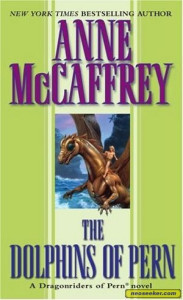 T: *sigh* Yes. That characterisation was really off. McCaffrey seemed to work really hard to explain Aramina’s attitude but it just didn’t fly. I could get it to a certain point, because in her own short story and in Renegades, there were some aspects of her personality that could lend themselves to her becoming overprotective and handling things in a way that might seem strange, but she really does go over the top, and it makes no sense in the context of the life they lead. It makes less sense that Jayge never addresses it with her and Readis, or that Alemi doesn’t prod him to do so!
T: *sigh* Yes. That characterisation was really off. McCaffrey seemed to work really hard to explain Aramina’s attitude but it just didn’t fly. I could get it to a certain point, because in her own short story and in Renegades, there were some aspects of her personality that could lend themselves to her becoming overprotective and handling things in a way that might seem strange, but she really does go over the top, and it makes no sense in the context of the life they lead. It makes less sense that Jayge never addresses it with her and Readis, or that Alemi doesn’t prod him to do so!
M: Exactly! Where is the changeover? It’s like she goes from zero to ninety in no space. It makes her come off a bit crazy. And the fact everyone else either never acknowledges it or handwaves it away is so out of character.
And other than that, we get short bits with Menolly and Mirrim, and stand-in characters for sisters, etc. We’ve hit this point where women are becoming equal, at least that’s what we’re being fed, so where are they?
T: Well, as you know Marisol, the perception of women as equal is really at about 15%, right? 
February 3, 2016
Revisiting Pern, the great McCaffrey reread: THE CHRONICLES OF PERN: FIRST FALL
Tehani and Marisol bonded over Pern (and Doctor Who) at a science fiction convention, decided that it was time for a reread of the series, and really, they should blog about that. They are reading in Anne McCaffrey’s preferred way, which is basically publication order.
 Pern Series –
The Chronicles of Pern: First Fall
Pern Series –
The Chronicles of Pern: First Fall
T: Well it turns out that most of what’s in this book is basically half of what I (mis)remembered as being in Dragonsdawn. Even the first story, “The Survey: P.E.R.N.”, which is about the survey ship that first found the planet, could have been a prologue in Dragonsdawn. The last piece, “Rescue Run” in which a ship comes across the distress beacon Ted Tubberman sent out and finds a despotic Stev Kimmer still alive and awaiting rescue, reads as a final epilogue to that same book. The other three pieces, “The Dolphins’ Bell”, “The Ford of Red Hanrahan” and “The Second Weyr” honestly read to me like they were edited out of Dragonsdawn for length!
M: I wondered the same thing – were these all edits taken out, or afterthoughts she’d never been able to put in? Some of the detailing, like with Tillek and the dolphins in “The Dolphin’s Bell”, would have dragged the book out, I suspect. Then again, “The Second Weyr” wouldn’t have really fit the arc in Dragonsdawn. I actually would have loved a dragon-focused book based on that time period rather than more survivor-based, as my love of Pern comes from the dragons and the way that impacts everything.
T: I agree they wouldn’t have fit in to Dragonsdawn but you can certainly see where they could have gone. And I agree that we got a bit shortchanged on the first dragons – there was so much potential to explore there!
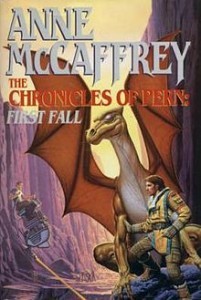 M: This was my first time reading these stories, so I had no idea that Kimmer lived. What a jerkoff! I mean, the whole story was great, because it was like reading a what-if, post-apocalypse spin-off. The idea no one else survived except Kimmer and his small harem is both a great what if and a bit of a trainwreck read. All of these emotions came pouring out for me as I relived his part in the betrayal of the first colony, and quite a bit of sadness as I realized Benden, Admiral Bendon’s survivor, would never have a chance to find out that he did survive, do all of these great things, and Kimmer was wrong.
M: This was my first time reading these stories, so I had no idea that Kimmer lived. What a jerkoff! I mean, the whole story was great, because it was like reading a what-if, post-apocalypse spin-off. The idea no one else survived except Kimmer and his small harem is both a great what if and a bit of a trainwreck read. All of these emotions came pouring out for me as I relived his part in the betrayal of the first colony, and quite a bit of sadness as I realized Benden, Admiral Bendon’s survivor, would never have a chance to find out that he did survive, do all of these great things, and Kimmer was wrong.
T: Maybe I didn’t want to look too closely at it, but I couldn’t quite figure out the family generations of the little lost colony – a bit ick to say the least! I had read it before, more than once, and it still surprised me! I’d forgotten entirely.
M: Plus, there is that deeply delicious I wish slice of revenge pie. Kimmer would have an apoplexy if he saw what happened to the colonists. Then again, there’s a part of me that has wondered if he lied so well about them dying that he believed it, too… He’d be the sole survivor with Avril’s plan to leave with riches galore. Smart tactic. For a jerkoff.
T: I think it was clear in Dragonsdawn that he was smart (cunning, perhaps?) but I didn’t peg him as being *quite* that selfish and self-centred. I guess thinking you’re the only survivors of the apocalypse wouldn’t have helped his mental state.
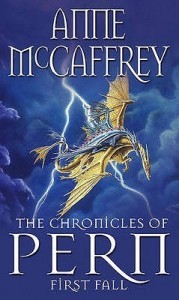 M: “Survey” was short and sweet; and really, it had no place here. It would have been a better read as a prologue or first chapter in the last book than the rehashed synopsis we received in Dragonsdawn. I felt like the information about the survey came up an awful lot in the book, and I think this would have done a better job cementing the idea than the rehashings.
M: “Survey” was short and sweet; and really, it had no place here. It would have been a better read as a prologue or first chapter in the last book than the rehashed synopsis we received in Dragonsdawn. I felt like the information about the survey came up an awful lot in the book, and I think this would have done a better job cementing the idea than the rehashings.
T: I was a bit disappointed in “Survey”, because it contradicts information about Avril that we get in Dragonsdawn. That should have been fact-checked! Although I like the idea that part of the reason the survey was incomplete was the shortage of qualified team members.
M: Confession time: I have a super large love affair with The Dolphins of Pern. Something I’m wondering if I will cringe at as I read it for the first time in, oh, ten years? Probably longer. I read it in middle and high school, when I dreamed daily of being taken away by talking animals to any place that didn’t include football and cheerleaders. Coming from that love of dolphins and that book in particular, I found myself much less enthused reading the short story. It was far more interesting to read about Tillek and Theo, and that development than the dolphins.
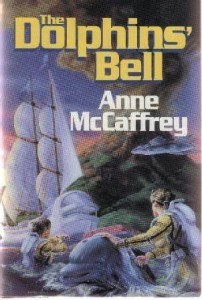 T: “The Dolphin’s Bell” is probably more interesting read with The Dolphins of Pern in your head, though, because it’s absolutely fascinating to see how that group maintained their societal structure through the centuries! Theo and Tillek were interesting, yes, but why did there have to be such an age difference? She’s VERY young for him!
T: “The Dolphin’s Bell” is probably more interesting read with The Dolphins of Pern in your head, though, because it’s absolutely fascinating to see how that group maintained their societal structure through the centuries! Theo and Tillek were interesting, yes, but why did there have to be such an age difference? She’s VERY young for him!
M: True, but seeing an age gap couple that no one put down was refreshing. Although I would have enjoyed a role reversal. Seems people always ok the older man with younger girl, but not the reverse. I guess that wouldn’t work well for their populating ways though, haha.
In my dream world, if we’d had “The Ford of Red Hanrahan” and “The Second Weyr” put in a book, I could have had that dragon story post settling the north. It’s enough to make me wistfully sigh, because you know even back then publishers didn’t appreciate what an amazing story world (aka moneymaker) they had in Pern.
T: I agree – more about the first Benden Weyr team, and the expansion of the weyrs in general, would have made a great book. More Sorka and Sean! More about how the Weyr society evolved! Because that’s a quite thought-provoking element of the books, the fact that Weyr life is rather different and generally more open than Hold life. More needed!
I think “The Ford of Red Hanrahan” is my favourite story in the book. I’m a Ruatha fan, as we’re positioned to be as readers, and I really do love this story about its origins.
M: It’s funny, because I love sci-fi stories, and I love the sci-fi elements to Pern, but reading the previous book was the most tedious still, and reading these non-dragon stories was not a favorite. I mean, I love story backgrounds and flavoring as much as the next nerd, but because so much of this was well intoned in the first books, I felt like I didn’t learn enough that was ‘new’, as ridiculous as it may seem.
T: Not ridiculous! It was a fleshing out of backstory, with only a few surprises, which can be a problem of prequels, I guess. And it’s also the contrast of a novel to a bunch of loosely connected stories – a different reading experience. I enjoyed revisiting it, but I definitely wanted more depth for most of the stories.
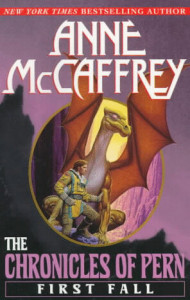 Previously, in the Great Pern Reread of 2015:
Previously, in the Great Pern Reread of 2015:
The Harper Hall trilogy (Dragonsong, Dragonsinger, Dragondrums)
Moreta: Dragonlady of Pern / Nerilka’s Story
The post Revisiting Pern, the great McCaffrey reread: THE CHRONICLES OF PERN: FIRST FALL appeared first on FableCroft.
January 28, 2016
60 hours to go for IN YOUR FACE!
There are just over 60 hours left in our In Your Face crowdfunding and pre-order campaign. Thank you so much to every person who has shared or backed the campaign, and to our incredible authors who have talked about the often very personal genesis of each of their stories (read about them via the links here).
We’re still chasing our stretch goal of pro-rates for all the original stories in the collection, so this last 60 hours could be huge!
The book comprises original and reprinted speculative fiction stories that deal with very provocative themes. These stories are confronting but with a firm purpose – they are pieces that will perhaps make readers uncomfortable because they are a bit too hard-hitting or close to the bone, but which interrogate these themes and ideas, and make a point about the world we live in.
If you’d like to support the book and pre-order your copy (in print or ebook – still fantastic pre-order prices available), you can back the campaign here, for as little as $8.00 for an ebook.
The post 60 hours to go for IN YOUR FACE! appeared first on FableCroft.
January 25, 2016
Tehani on Galactic Suburbia – another life goal achieved!
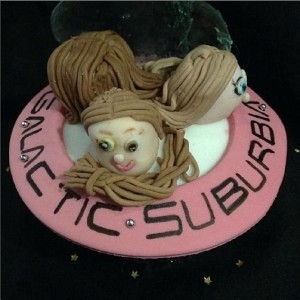 I was absolutely over the moon to be invited to take part in the 2015 Galactic Suburbia’s New Year Special episode, which went live on December 31. Along with a bunch of other fabulous women, I got to chat about the year that was, have my own little Culture Consumed session AND share cool stuff we’re doing at FableCroft in 2016. I’ve always been such a huge Galactic Suburbia fangirl (and of course, consider Alex, Alisa and Tansy as good friends!), so this was definitely a highlight for me. Thanks for having me, Galactic Suburbians, and for your great show.
I was absolutely over the moon to be invited to take part in the 2015 Galactic Suburbia’s New Year Special episode, which went live on December 31. Along with a bunch of other fabulous women, I got to chat about the year that was, have my own little Culture Consumed session AND share cool stuff we’re doing at FableCroft in 2016. I’ve always been such a huge Galactic Suburbia fangirl (and of course, consider Alex, Alisa and Tansy as good friends!), so this was definitely a highlight for me. Thanks for having me, Galactic Suburbians, and for your great show.
You can listen to the podcast (there are lots of other cool people talking too, not just me  ) on iTunes or via the Galactic Suburbia Podbean.
) on iTunes or via the Galactic Suburbia Podbean.
The post Tehani on Galactic Suburbia – another life goal achieved! appeared first on FableCroft.
January 21, 2016
Ten days left for crowdfunding IN YOUR FACE
We are so very delighted to have now tripled our target, with the tally passing $1500 earlier today – to all our wonderful backers, THANK YOU! To every single person who has shared the campaign with their networks, friends, families and random people on the street, THANK YOU! To our amazing authors, who continue to astonish with their thoughtful posts about their stories, THANK YOU!
The tally so far means that we have been able to add several more stories to the anthology, taking us to 21 pieces (including four reprints), and a total of over 135,000 words (check out the amazing Table of Contents). We’ve also been able to increase the payment for authors of stories longer than 5,000 words (to pay them for the full length of the story), and the payment for reprint pieces. That’s fantastic!
But we’ve still got a dream! In order to pay pro rates of six cents per word for the original stories in the anthology, we estimate we need to reach a goal of $4,500 – and we’ve still got ten days to try for it! We’re happy to aim for the stars even if we don’t quite make it though, because even if we only get to $2,500, we can increase the per word payment, which would be fabulous.
So please, tell your friends! Share with your networks and check out the blog posts about the stories – this book is going to knock your socks off!
If you would like to support the the In Your Face Pozible campaign, you can do so here – thank you!
The post Ten days left for crowdfunding IN YOUR FACE appeared first on FableCroft.
January 13, 2016
Revisiting Pern, the great McCaffrey reread: ALL THE WEYRS OF PERN
Tehani and Marisol bonded over Pern (and Doctor Who) at a science fiction convention, decided that it was time for a reread of the series, and really, they should blog about that. They are reading in Anne McCaffrey’s preferred way, which is basically publication order.
 Pern Series –
All the Weyrs of Pern
Pern Series –
All the Weyrs of Pern
T: This is the book you could really end the series with. And maybe McCaffrey should have, though I’ll reserve judgement until I’ve reread Dolphins and Skies (and the Masterharper), because I don’t think I’ve read some of those more than once, so don’t really remember much about them. I’ve not included The Chronicles of Pern in that, because everything in it comes from the beginning, prior to or following Dragonsdawn.
M: I’d be really sad if we didn’t include Dolphins, that’s one of my favorites from my childhood, although we shall see if that’s still the case.
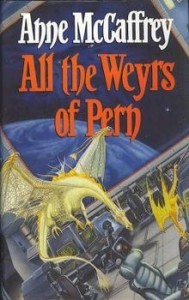 T: Oh, we’re totally doing it, I’m just saying that the story cycle really completes nicely in All the Weyrs…
T: Oh, we’re totally doing it, I’m just saying that the story cycle really completes nicely in All the Weyrs…
M: I remember being surprised they came out with more books after, because it seemed like they were going to stop after this one. At the same time, though, I really enjoyed reading about the ‘fallout’ post AIVAS in the next books, and I’ve got some thoughts on that I’ll keep shushed til we get there.
T: To be honest, I didn’t love this book as much as I remember loving it in past readings. Partly I think it’s because there are still issues with gender roles that glare at me – in Chapter 2, for example, when all the men are doing the bidding of AIVAS, Lessa, Menolly and Jancis and some drudges take on the cleaning… Really? REALLY?! Two of the most powerful and well-respected women on Pern ending up on cleaning duty?
M: I feel like some things in their culture are harder to let go of in the ingrained sense than others. Certainly if Lessa didn’t feel like cleaning, she wouldn’t have. I like to think (hope) that they’re moving towards equal rather than one gender.
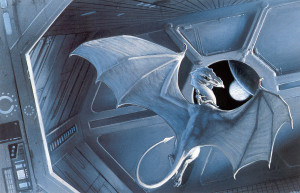 T: I think I forgot that this was, essentially, the sequel to The White Dragon. It’s Jaxom’s story more than anyone else’s, and while I love Jaxom to bits, that surprised me a bit and also meant that rereading it now, when I tend not to read many books with male protagonists these days, was an interesting experience. Particularly as the focus was most definitely on the male characters in general. Whole swathes of pages go by with no women featured or even present, at times.
T: I think I forgot that this was, essentially, the sequel to The White Dragon. It’s Jaxom’s story more than anyone else’s, and while I love Jaxom to bits, that surprised me a bit and also meant that rereading it now, when I tend not to read many books with male protagonists these days, was an interesting experience. Particularly as the focus was most definitely on the male characters in general. Whole swathes of pages go by with no women featured or even present, at times.
M: Do you think that might be because so few of the notable people are women? I mean, with AIVAS discovered, it’s understandable that leaders rather than just anyone would be allowed access to Landing first. There’s an argument in there for women being able to reach said spots as well, but I noted a few instances where things were now casually mentioned as new men and women in Crafthalls and working on projects to help defeat Thread. Able hands are now regarded as just that, and the fact they’re not arguing about “the wimmins!” working is a good step forward for this generation. I would love to see more, but considering where the petulant, hidebound individuals started, I think the growth has been good.
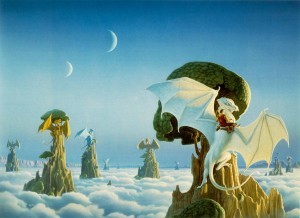 T: Yeah, but the books have always harped on about how the Weyrwomen are as important to the Weyrs as the Weyrleaders (all evidence to the contrary notwithstanding…) so I guess it just would have been nice to see more females given page time. Particularly Menolly, Lessa, Sharra, Jancis and the like. Seems like half the time they are mentioned it’s only to talk about their latest pregnancy or baby!
T: Yeah, but the books have always harped on about how the Weyrwomen are as important to the Weyrs as the Weyrleaders (all evidence to the contrary notwithstanding…) so I guess it just would have been nice to see more females given page time. Particularly Menolly, Lessa, Sharra, Jancis and the like. Seems like half the time they are mentioned it’s only to talk about their latest pregnancy or baby!
M: I know! What was with that? I know we were going over four years, but I would’ve liked to have had more of them, in particular Menolly as you’d think she’d be allowed to be as invested as Piemur and Robinton.
T: Exactly. It’s just a bit off.
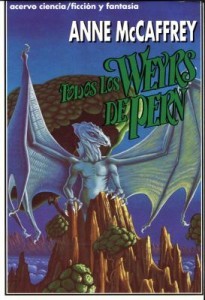 M: One thing I want to touch on, though, speaking of Ruth and Jaxom – them doing the impossible. How incredible is it they managed to jump 50 years into the future to confirm everything worked as AIVAS said, and then timed it back 1800 years for the first engine?! Freaking incredible. The entire last part of the book still had me on the edge of my seat while simultaneously cheering all the incredible leaps they made. Who said advancement was only for technology?!
M: One thing I want to touch on, though, speaking of Ruth and Jaxom – them doing the impossible. How incredible is it they managed to jump 50 years into the future to confirm everything worked as AIVAS said, and then timed it back 1800 years for the first engine?! Freaking incredible. The entire last part of the book still had me on the edge of my seat while simultaneously cheering all the incredible leaps they made. Who said advancement was only for technology?!
T: I really liked that AIVAS’s plan were very much structured around a reliance on Ruth’s abilities, and Jaxom’s willingness to take the risks needed. It was a lovely full circle from the early days of their story, when others would have let Ruth die, or separated them. I think it had a nice little message, in that ending.
 M: This may sound weird, but there was almost a fondness for me when the anti-progress people came out in angry waves. Because they’re so expected when big technological and societal advances hit, I had this “finally” moment when they tried to sabotage AIVAS. I like problems that can addressed rather than rumors which are difficult to pin, because I wanted to see everyone triumph over the angry mobs. I think of them as the Abominators, although they never named themselves.
M: This may sound weird, but there was almost a fondness for me when the anti-progress people came out in angry waves. Because they’re so expected when big technological and societal advances hit, I had this “finally” moment when they tried to sabotage AIVAS. I like problems that can addressed rather than rumors which are difficult to pin, because I wanted to see everyone triumph over the angry mobs. I think of them as the Abominators, although they never named themselves.
Every Pern story isn’t complete without a good cry, and (massive spoiler if you’ve never read them), having Robinton die after everything they’ve did is the hardest death in all of the books. He’s a force of nature, and even though it was probably one of the kindest deaths a person could have, going to sleep like that, a Pern without him is an incomplete world. My cat judged me horribly when I cried and hugged him.
T: Oh my yes. I had, again, forgotten that it happened in this book. As we were winding up for the ending I’m reading and going, wait, I have a bad feeling here… So many sobs.
M: Maybe this is where the series should have ended. Man, I’m really looking forward to reading the rest. (But Masterharper goes back in time and therefore doesn’t count for ‘ending’, as it chronologically is much earlier and I NEED my Robinton!)
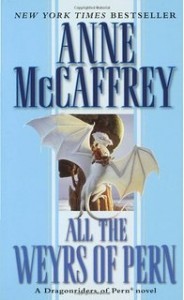 Previously, in the Great Pern Reread of 2015:
Previously, in the Great Pern Reread of 2015:
The Harper Hall trilogy (Dragonsong, Dragonsinger, Dragondrums)
Moreta: Dragonlady of Pern / Nerilka’s Story
The post Revisiting Pern, the great McCaffrey reread: ALL THE WEYRS OF PERN appeared first on FableCroft.
January 11, 2016
Sparking In Your Face: Cat Sparks
Cat Sparks is a multi-award-winning author, editor and artist whose former employment has included: media monitor, political and archaeological photographer, graphic designer and manager of Agog! Press amongst other (much less interesting) things. She’s currently fiction editor of Cosmos Magazine while simultaneously grappling with a PhD on YA climate change fiction. Her debut novel, Lotus Blue, is forthcoming from Talos Press in February 2017.
A friend of mine, an English teacher once remarked upon a curiosity amongst her class of 17-year-old boys. When asked for the worst thing they could think of in regards to their own futures, all apparently cited the same thing. That the absolutely worst thing ever would be to get blind drunk and wake up in bed next to a fat girl.
My friend was gobsmacked. Surely the boys were more worried about employment, or climate change, terrorism, HECS debt, rising house prices or maybe speeding and getting mangled in a car wreck? Nope. Unanimously fat chicks were the epitome of social and personal apocalypse.
Which got me thinking…
I reckon every Aussie woman larger than a size 14 has likely experienced a man criticising her appearance. I’m not talking about garment choices, I’m talking about overweight, and the invisible accompanying license to express contempt.
My In Your Face story, “No Fat Chicks”, is set in the near future where a mystery virus has rendered all women obese. The story focuses on a group of male friends not coping well at all with the situation.
I’d had the idea for this one for some time, but hadn’t known where or how to start. I recognised the story would be tricky – but all my stories are difficult these days. Perhaps I should have realised a sci-fi semi-satire piece might prove particularly troublesome to place.
An Australian literary publication invited me to sub a story. They sat on “No Fat Chicks” for months before finally giving it the flick. My rejection came with a half page email mansplaining the intricate mechanics of human attraction. As far as that particular editor was concerned, I simply didn’t know how such things worked.
I sent the story out again a dozen times. A few submissions scored a polite ‘no thanks’ but other rejections read more along the lines of “ew – get this thing out of my face!” Even a sci-fi feminist magazine wouldn’t touch it. They weren’t sure why they didn’t want it, but they didn’t. A prominent editor friend had a look and advised me that the story was too misogynist.
It wasn’t the fact of the rejections that bothered me so much as the wording of them. As a writer of 25+ years in the saddle, I’m no stranger to editorial rejection, no kind of delicate little flower who expects her words to be regarded as precious gifts. I’m an editor myself – and a bit of a hardarse – well aware that no can mean no for many reasons.
“No Fat Chicks” is not about #allmen, but the men it describes are absolutely real. For research, I waded through a swamp of unpleasant websites. The kind that advocate dating girls with eating disorders as they’re hot in the sack and easy to control. And then there was the miserable hatefest known as @fatshamingweek. Don’t go there – I really wish I hadn’t.
To be fair on the editors who rejected my submissions, I tweaked the story every time it bounced. Perhaps my earlier drafts didn’t do my ideas proper justice. Perhaps my writing needed a bit more polish. But the overwhelming feeling I experienced with each no was that I wasn’t supposed to be telling this tale at all.
Western women are raised with the belief that it’s more important to be beautiful than anything. We can all name five supermodels or screen sirens, but how do we score naming five top female CEOs or scientists?
There are many men out there who consider ‘fat chicks’ a blight upon the landscape. They believe the world was made for them alone. That women and girls are servants and accessories, and all are supposed to be petite and small. Anything else is unnecessary and offensive. This story is about those men. It is not about all men everywhere, any more than any other story could be expected to reflect all men everywhere.
Thank you Tehani for giving “No Fat Chicks” a go.
Editor’s Note: Cat’s story is the true spark that brought the In Your Face anthology into being. I wasn’t going to do an anthology this year. “No Fat Chicks” is the reason the book came to life.
If Cat has sparked your interest in the In Your Face anthology and the powerful stories it contains, you might like to support the crowdfunding campaign by pre-ordering the book (and lots of other goodies) at Pozible. And please feel free to share with your networks!
You can find more posts by our authors linked here.
The post Sparking In Your Face: Cat Sparks appeared first on FableCroft.
January 6, 2016
Revisiting Pern, the great McCaffrey reread: THE RENEGADES OF PERN
Tehani and Marisol bonded over Pern (and Doctor Who) at a science fiction convention, decided that it was time for a reread of the series, and really, they should blog about that. They are reading in Anne McCaffrey’s preferred way, which is basically publication order.
 Pern Series –
The Renegades of Pern
Pern Series –
The Renegades of Pern
M: This is the book I always think of as “The Gypsy Book”. I always forget all the OTHER stuff that happens in it.
T: The events of The White Dragon, The Renegades of Pern and All the Weyrs of Pern are apparently just one big jumble in my head, because I really had no idea which events took place in what book (or sometimes, short story…), so it was wonderful fun revisiting these to find out!
M: Given the ridiculously wide timeframe this book covers, it’s no surprise. I mean, we see Fax before he’s been killed. That’s ages ago!
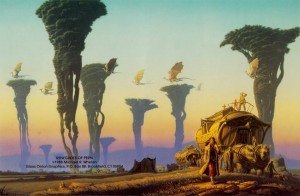 T: At first I felt like we really *should* have skipped Moreta/Nerilka and Dragonsdawn to come back to later, because Renegades runs concurrently in the chronology to Dragonflight, Dragonquest, the Harper books and The White Dragon (as well as a couple of short stories!) for a big chunk! However, as I read on, I realised that it probably would have been a bit irritating to read the book in too close a proximity, and in fact the break really made this a better read. It also helps one gloss over the little continuity errors…
T: At first I felt like we really *should* have skipped Moreta/Nerilka and Dragonsdawn to come back to later, because Renegades runs concurrently in the chronology to Dragonflight, Dragonquest, the Harper books and The White Dragon (as well as a couple of short stories!) for a big chunk! However, as I read on, I realised that it probably would have been a bit irritating to read the book in too close a proximity, and in fact the break really made this a better read. It also helps one gloss over the little continuity errors…
M: Too much dipping in the same pot, I agree. Even if Dragonsdawn is my least favorite story (so far as I remember). This book is like the book that shouldn’t be. It’s vignettes sliced up over an enormously long time.
T: Renegades certainly has the most ensemble cast of any of the books so far, I think. We get multiple widely varied points of view, with the dragonriders and harpers interesting quite sidelined for most of the story. Quite a fascinating choice McCaffrey made there!
M: You’d think given the sheer number of POVs that this would feel dull. It’s a rare used storytelling form that, for whatever reason, works. Although if you read this as the first book ever in the Pern series, you’d probably think the series was terrible.
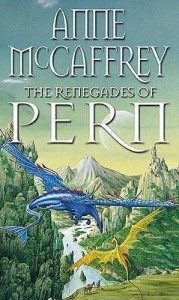 T: Does this feel to you a little like this was two distinct stories kind of mashed together and finessed to have some links? The first half has a really scattershot approach, with lots of little vignettes of different characters and hopping about in time and place, while the last part of the book simply runs chronologically and mainly follows the usual beloved characters from earlier books, who barely appear in the first half! McCaffrey has certainly pulled two shorter works together into one novel before (Dragonquest was partly – mostly? – comprised of two separate novellas, “Weyr Search” and “Dragonrider”, both published by Analog in 1967, the year before the novel came out), so it would not surprise me to discover that elements of Renegades were originally separate works, or at least, had it had its origins as separate books.
T: Does this feel to you a little like this was two distinct stories kind of mashed together and finessed to have some links? The first half has a really scattershot approach, with lots of little vignettes of different characters and hopping about in time and place, while the last part of the book simply runs chronologically and mainly follows the usual beloved characters from earlier books, who barely appear in the first half! McCaffrey has certainly pulled two shorter works together into one novel before (Dragonquest was partly – mostly? – comprised of two separate novellas, “Weyr Search” and “Dragonrider”, both published by Analog in 1967, the year before the novel came out), so it would not surprise me to discover that elements of Renegades were originally separate works, or at least, had it had its origins as separate books.
M: I’d take it a step further and say it feels like snippets that got cut from her previous books and combined into a book that shouldn’t work, but totally does. I mean, from Fax’s time on to AIVAS’s discovery – that’s at least 30 years. That’s nuts! I mean, this book is basically flavor – it explains a lot of details behind the big things that happened, but at least a third was unnecessary to drive the stories forward.
Maybe this was a case of “No, we need a minimum wordcount”?
T: Not sure we’ll ever know, now, but yes, it definitely feels like a novel made up of bits and pieces, particularly in the first half.
I was interested to see how thoroughly awful the self-styled “Lady Holder” Thella became in the novel, especially considering that in some ways, McCaffrey sets her up quite sympathetically. Thella has reason to be pretty cranky about having no opportunity to take “hold” of Telgar – she is the eldest, she clearly has the training, and she was a favourite. It’s institutionalised sexism at work, and I kind of didn’t blame her for being upset! McCaffrey seemed to be making a comment about that sort of thing but that dissipated as the novel went on and Thella stopped being likeable and started being cruel and horrible.
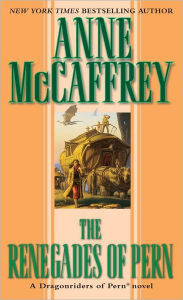 M: Thella lost any sympathy for me when she threw a mug at people just to hurt them. She’s a sadist who, had she led, would have hurt her people. I don’t think she would have ended up that way, however, if she hadn’t been put in the position she’d been cornered into. A dog who’s taught to fight its way out of the corner will do so, and Thella’s never known anything else. I completely agree about the underlying statement about sexism. She could have been a great leader, but was doomed from the start to go down the other path, sadly.
M: Thella lost any sympathy for me when she threw a mug at people just to hurt them. She’s a sadist who, had she led, would have hurt her people. I don’t think she would have ended up that way, however, if she hadn’t been put in the position she’d been cornered into. A dog who’s taught to fight its way out of the corner will do so, and Thella’s never known anything else. I completely agree about the underlying statement about sexism. She could have been a great leader, but was doomed from the start to go down the other path, sadly.
T: This is one book where having the “side story” (in this case, Aramina’s story “The Girl Who Heard Dragons”) separate to the novel is a real detriment. I mean, without reading “The Smallest Dragonboy”, the sudden featuring of K’van and Heth doesn’t really make sense to the reader, but there are plenty of dragon and rider characters coming and going, so it doesn’t have much impact. Aramina, though, is crucial to Thella’s story, and important blocks of action shown in “The Girl Who Heard Dragons” are only glimpsed at in Renegades, and the novel suffers a bit for that.
M: I didn’t even think about K’van’s sudden appearance. I mean, it seems to happen enough it didn’t register as sudden to me. I’ve never actually read those short stories, so I’m looking forward to reading them as we head along and see if I feel the same way as you.
T: Ooh, I didn’t know you hadn’t read them! This ought to be fun  I wonder if anyone has fan-made an omnibus edition of the Pern books and stories that intercuts every part of them into the chronological sequence of events…
I wonder if anyone has fan-made an omnibus edition of the Pern books and stories that intercuts every part of them into the chronological sequence of events…
M: You could basically splice all those shorts in with this anyways, and it wouldn’t even change the tone of the book. It really is that broad!
T: Too true. I think I liked the second half more than the first, but mostly because that all fits in with the bigger story arc better. And as we move on to All The Weyrs of Pern, the events of that last part become pretty important…
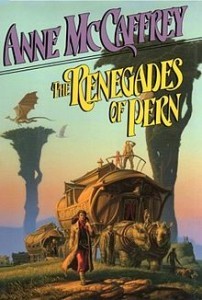 Previously, in the Great Pern Reread of 2015:
Previously, in the Great Pern Reread of 2015:
The Harper Hall trilogy (Dragonsong, Dragonsinger, Dragondrums)
Moreta: Dragonlady of Pern / Nerilka’s Story
The post Revisiting Pern, the great McCaffrey reread: THE RENEGADES OF PERN appeared first on FableCroft.

